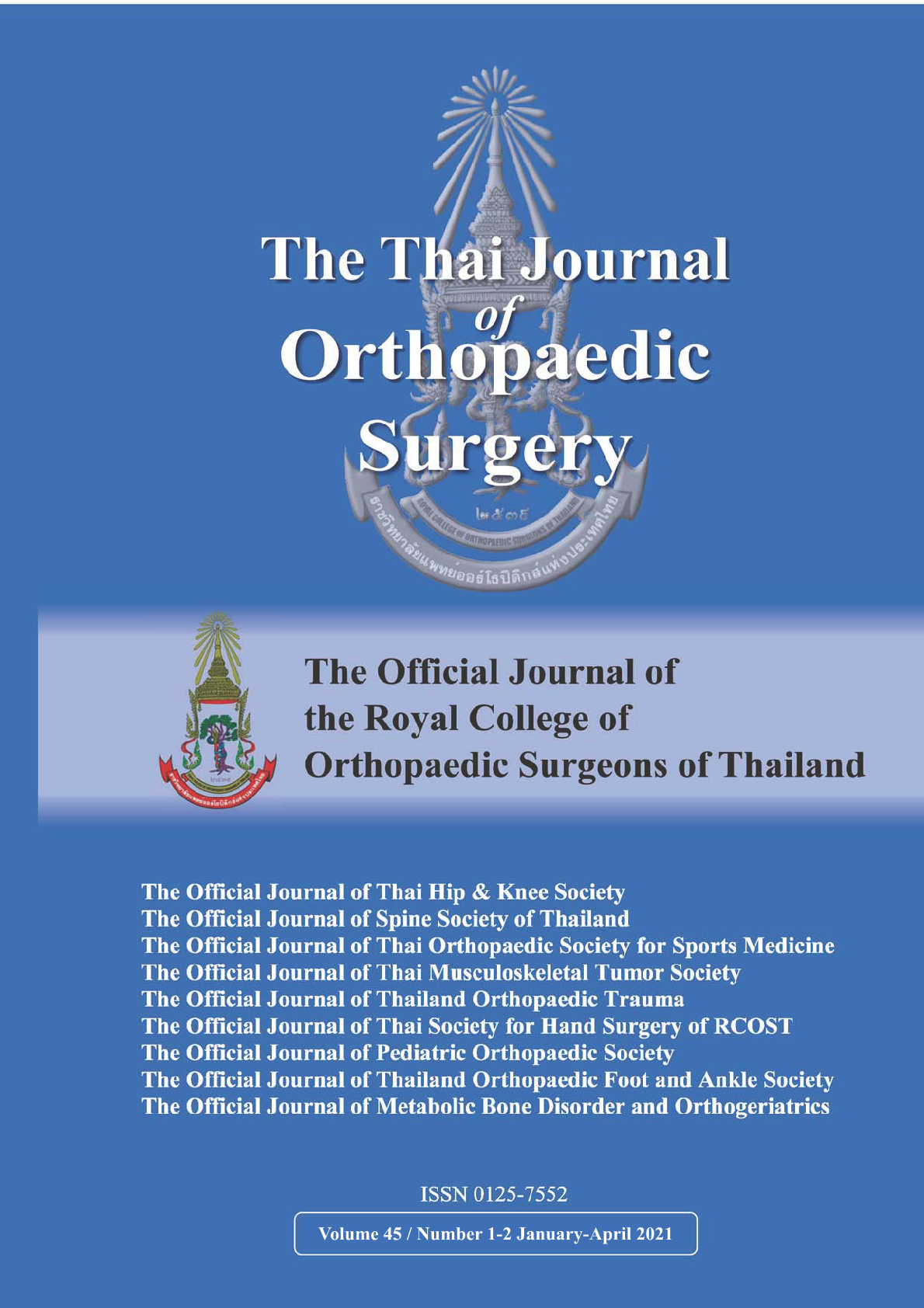Surgical Outcome of the Rod Derotation Technique in Adolescent Idiopathic Scoliosis (AIS) Correction
Main Article Content
Abstract
Purpose: To evaluate the results of deformity correction in adolescent idiopathic scoliosis (AIS) with spinal column realignment (SmartlinkTM), and determine if it is an effective tool for the deformity correction of adolescent idiopathic scoliosis with a good result.
Methods: We retrospectively reviewed 28 AIS patients. All patients underwent posterior spinal fusion and deformity correction using the rod derotation technique. The patients were aged 12-23 years with a mean age of 16.6 years. The average follow-up time was 3 years. The SmartlinkTM was used for the spinal column realignment. The navigator system and nerve integrity monitor (NIM) were used during the operations.
Results: No patient had a serious complication. For Lenke type 1, the deformity was corrected in the coronal plane for an average of 87%. In Lenke type 2, the deformity was corrected in the coronal plane for an average of 80% in the main thoracic, and 66.0% in the proximal thoracic. In Lenke type 3, the deformity was corrected in the coronal plane of the main thoracic 80% and thoracolumbar/lumbar 82. In Lenke type 5, the corrected deformity thoracolumbar/lumbar average was 90%. In Lenke type 6, the corrected deformity thoracolumbar/lumbar average was 89%, and the corrected deformity main thoracic average was 87%.
Conclusion: The use of the spinal column realignment SmartlinkTM had a good result for the correction of AIS deformities, and it was safe when combined with the O-arm navigator and NIM for nerve monitoring during pedicle screw placement for the correction of AIS deformities.
Article Details
References
2. Konieczny MR, Senyurt H, Krauspe R. Epidemiology of adolescent idiopathic scoliosis. J Child Orthop. 2013; 7: 3-9.
3. Nissinen M, Heliovaara M, Ylikoski M, Poussa M. Trunk asymmetry and screening for scoliosis: A longitudinal cohort study of pubertal schoolchildren. Acta Paediatr. 1993; 82: 77-82.
4. Taylor TKF, Cumming RG, Jones FL, McCann RG, Plunkett-Cole M. The epidemiology and demography of adolescent idiopathic scoliosis. Spine: State of the Art Reviews. 2000; 14: 305-11.
5. Lenke LG, Betz RR, Harms J, Bridwell KH, Clements DH, Lowe TG, et al. Adolescent idiopathic scoliosis: a new classification system to determine extent of spinal arthrodesis. J Bone Joint Surg Am. 2001; 83: 1169-81.
6. Poitras B, Mayo NE, Goldberg MS, Scott S, Hanley J. The Ste-Justine adolescent idiopathic scoliosis cohort study. Part IV: Surgical correction and back pain. Spine (Phila Pa 1976). 1994; 19: 1582-8.
7. Weinstein SL, Zavala DC, Ponseti IV. Idiopathic scoliosis: long-term follow-up and prognosis in untreated patients. J Bone Joint Surg Am. 1981; 63: 702-12.
8. Harrington PR. Treatment of scoliosis: correction and internal fixation by spine instrumentation. J Bone Joint Surg Am. 1962; 44-A: 591-610.
9. Cotrel Y, Dubousset J, Guillaumat M. New universal instrumentation in spinal surgery. Clin Orthop Relat Res. 1988; 227: 10-23.
10. Dubousset J, Cotrel Y. Application technique of Cotrel-Dubousset instrumentation for scoliosis deformities. Clin Orthop Relat Res. 1991; (264): 103-10.
11. Lee S-M, Suk S-I, Chung E-R. Direct vertebral rotation: a new technique of three-dimensional deformity correction with segmental pedicle screw fixation in adolescent idiopathic scoliosis. Spine (Phila Pa 1976). 2004; 29: 343-9.
12. Kadoury S, Cheriet F, Beauséjour M, Stokes IA, Parent S, Labelle H. A three - dimensional retrospective analysis of the evolution of spinal instrumentation for the correction of adolescent idiopathic scoliosis. Eur Spine J. 2009; 18: 23-37.
13. Suk SI, Lee CK, Kim WJ, Chung YJ, Park YB. Segmental pedicle screw fixation in the treatment of thoracic idiopathic scoliosis. Spine (Phila Pa 1976). 1995; 20: 1399-405.
14. Lenke LG, Edwards CC II, Bridwell KH. The Lenke classification of adolescent idiopathic scoliosis: how it organizes curve patterns as a template to perform selective fusions of the spine. Spine (Phila Pa 1976). 2003; 28: S199-207.


